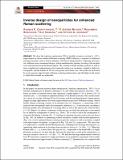Inverse design of nanoparticles for enhanced Raman scattering
Author(s)
Christiansen, Rasmus E; Michon, Jerome; Benzaouia, Mohammed; Sigmund, Ole; Johnson, Steven G
DownloadPublished version (2.210Mb)
Publisher Policy
Publisher Policy
Article is made available in accordance with the publisher's policy and may be subject to US copyright law. Please refer to the publisher's site for terms of use.
Terms of use
Metadata
Show full item recordAbstract
© 2020 Optical Society of America under the terms of the OSA Open Access Publishing Agreement We show that topology optimization (TO) of metallic resonators can lead to ∼102 × improvement in surface-enhanced Raman scattering (SERS) efficiency compared to traditional resonant structures such as bowtie antennas. TO inverse design leads to surprising structures very different from conventional designs, which simultaneously optimize focusing of the incident wave and emission from the Raman dipole. We consider isolated metallic particles as well as more complicated configurations such as periodic surfaces or resonators coupled to dielectric waveguides, and the benefits of TO are even greater in the latter case. Our results are motivated by recent rigorous upper bounds to Raman scattering enhancement, and shed light on the extent to which these bounds are achievable.
Date issued
2020Department
Massachusetts Institute of Technology. Department of Mathematics; Massachusetts Institute of Technology. Department of Materials Science and Engineering; Massachusetts Institute of Technology. Department of Electrical Engineering and Computer ScienceJournal
Optics Express
Publisher
The Optical Society